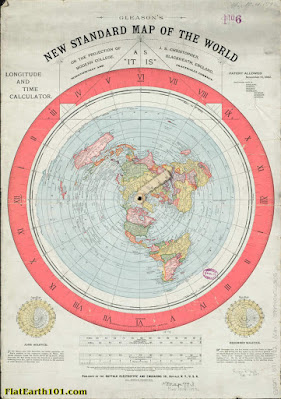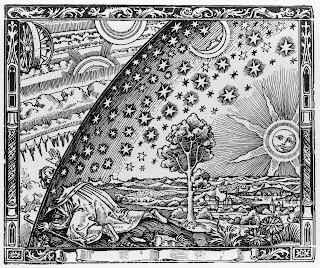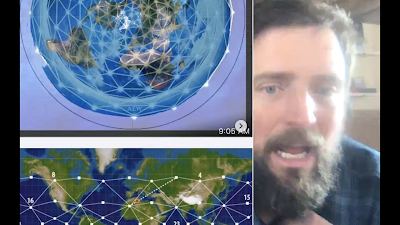The Myth of the Flat Earth
Fact.
My colleagues in academia say it all the time.
Here is my University of Chicago colleague Rocky Kolb, the Arthur Holly Distinguished Service Professor of Astronomy and Astrophysics, saying it in his 2006 Aims of Education Address to our entering first-years:
The fact that you have been admitted to an elite university is evidence that you know a lot. Although you know a lot, hidden among the things you think you know are things that ain’t so. It’s the same for us all. I can’t say what you know that ain’t so, anymore than I can say what I know that ain’t so. I only know we all have unknown knowns. I’m sorry, we all do.For example, it was once known that Earth is flat, it was once known that Earth is the center of our solar system, it was once known that the solar system is the center of our galaxy, and it was once known that our galaxy is the center of the universe. You may not believe this, but it wasn’t so long ago that everyone knew that Pluto was a planet. Now we all know those things just ain’t so. Now, no one believes Earth is flat and is at rest in the center of the universe, at least no one outside of the Kansas State Board of Education.
It was good of him (and Rocky is a good guy) to admit that we all think we know things that just ain’t so, but one of things that I know that Rocky seems not to have known in 2006 is that prior to say, A.D. 1492, anybody with the kind of elite education we purport to give our students at the University of Chicago, at least since there was an Academy in Athens, not to mention universities in medieval Europe, knew that the Earth was not flat, but round, particularly those pesky Christians (a.k.a. members of the Kansas State Board of Education) like Dante Alighieri (A.D. 1265-1321).
Likewise, from the top of the mountain of Purgatory, the Pilgrim Dante travels upward through the nesting spheres of the Moon, Mercury, Venus, Sun, Mars, Jupiter, Saturn, and Fixed Stars (in that order) to the sphere that moves all other spheres and beyond to the choirs of heaven. In the second canto of Heaven, Dante has a long discussion with Beatrice, his heavenly guide, about the “brilliant, solid, dense, and stainless cloud” of the first “star”—a.k.a. the Moon—and how his physical body could interpenetrate the sphere of the Moon. He is particularly interested in the dark blotches on the Moon that “there below, on earth, have made men tell / the tale of Cain.” Beatrice suggests an experiment with three mirrors to help him understand the difference between the light of the Fixed Stars and the light of the Moon, while at the same time describing the way in which the light of the Stars reaches down through the nested spheres of the planets.
What matters for our purposes (as Beatrice incidentally explains in Canto 2, but which is verified throughout their celestial ascent): The whole point of Heaven is to describe how the spheres of the Fixed Stars and planets are impelled by “the Love that moves the Sun and the other stars.” It is true that Dante considered the Earth as the center of this great wheeling system, but it was a system of spheres centered on a sphere. (NB: this does not make it a solar system. By definition, the Earth cannot be at the center of a solar system. Just saying.) In case you’re wondering, no, Dante was never hauled before the Inquisition for heresy, his Commedia was a best-seller, and nobody ever suggested that he was wrong about the shape of the Earth. (Unlike, of course, Galileo, whom everybody knows was hauled before the Inquisition for making fun of his friend, the Pope. Oh, wait, that’s not the story you heard? Talk about nested spheres!)
*
Tl;dr: Medieval Christians did not believe the Earth was flat. But somebody must have, right? Right? ‘Cause everyone knows that it was Columbus who proved the Earth was round! Certainly, Washington Irving (A.D. 1783-1859) knew it. He wrote a whole book about Columbus based on scrupulous historical research—a.k.a. a few months in the Spanish archives. This is the scene as Irving, better known as the author of such historical classics as “Rip Van Winkle” and “The Legend of Sleepy Hollow,” paints it in his History of the Life and Voyages of Christopher Columbus (1828). Columbus has been summoned to the Dominican convent of St. Stephen in Salamanca to testify before the learned doctors of Spain (book II, chapter IV):
What a striking spectacle must the hall of the old convent have presented at this memorable conference! A simple mariner, standing forth in the midst of an imposing array of professors, friars, and dignitaries of the church; maintaining his theory with natural eloquence, and, as it were, pleading the cause of the New World [which, of course, nobody at the time knew existed, but never mind—RFB].
Rather than addressing Columbus’s geographical arguments, the doctors “assailed” him with citations from the Scriptures—“the Bible and the Testament, the book of Genesis, the psalms of David, the Prophets, the epistles, and the gospels”—along with “the expositions of various saints and reverend commentators, St Chrysostome (sic) and St Augustine, St Jerome and St Gregory, St Basil and St Ambrose, and Lactantius Firmianus, a redoubted champion of the faith”:
Doctrinal points were mixed up with philosophical discussions, and a mathematical demonstration was allowed no truth, if it appeared to clash with a text of scripture, or a commentary of one of the fathers. Thus the possibility of antipodes in the Southern Hemisphere, an opinion so generally maintained by the wisest of the ancients, as to be pronounced by Pliny the great contest between the learned and the ignorant, became a stumbling block with some of the sages of Salamanca.
Perhaps the Salamancan sages—or, more likely, Irving—had not read their Dante, otherwise, of course, they would have known that the mountain of Purgatory was there in the Antipodes. Nor do they seem to have been reading their Augustine (which Galileo had); otherwise they would have known not to make scientific arguments on the basis of (potentially) figurative language. Still Irving:
Such were the unlooked for prejudices which Columbus had to encounter at the very outset of his conference, and which certainly relish more of the convent than the university.
To his simplest proposition, the spherical form of the earth, were opposed figurative texts of scripture. They observed, that in the Psalms, the heavens are said to be extended like a hide [“Extendens coelum sicut pellem. Psal. ciii. In the English translation it is Psalm civ, v. 3]; that is, according to the commentators, the curtain, or covering of a tent, which, among the ancient pastoral nations, was formed of the hides of animals; and that St Paul, in his epistle to the Hebrews, compares the heavens to a tabernacle, or tent, extended over the earth, which they thence inferred must be flat.
Columbus, who was a devoutly religious man, found that he was in danger of being convicted, not merely of error, but of heterodoxy.
In reality, what the learned doctors at Salamanca objected to was not Columbus’s exegesis of scripture, but (as even Irving admits) his mathematics: Columbus was wrong (they contended) not about the shape, but the circumference of the Earth—which, in fact, he was, as even Wikipedia knows:
Columbus estimated the distance to Japan to be only about 5,000 km (or only to the eastern edge of the Caribbean) while the true figure is about 20,000 km. The Spanish scholars may not have known the exact distance to the east coast of Asia, but they believed that it was significantly further than Columbus’s projection; and this was the basis of the criticism in Spain and Portugal, whether academic or among mariners, of the proposed voyage.
But, of course, what everybody remembers is that the doctors of Salamanca were religious bigots, while Columbus was right about the shape of the Earth.
*
Or was he? Until this year, I had never given any particular thought to the shape of the Earth, except to point out on a regular basis that medieval Christians knew the world was round. (I emailed Professor Kolb with references back in the day when I first read his Aims of Education remarks. He never got back to me.) But this is the year of 2020 vision, and I have been listening to Owen...and Owen has been talking about how the Earth is, in fact, flat.
You could say it has rocked my world.
I spent the day of the Election (because, why not?!) reading “200 Proofs the Earth is Not a Spinning Ball” by Eric Dubay on FlatEarth101.com. The proofs range from the view of the horizon at any altitude (flat) to the practice of surveying for engineering projects like canals and railways (no curvature). There are maps showing the likeliest routes of airplanes from one “hemisphere” to the other, mapped both on a globe and on the flat disc proposed by the Flat Earth theory. There are theories about Antarctica as a great Ice Wall and proposals for what the orbits of the Sun and the Moon would look like mapped onto a disc. There are photographs of landmarks taken from distances too far away to be visible with the purported curvature of the Earth. There are star maps and discussions of gravity (a.k.a. Newton’s Big Lie), questions about why the Sun seems to have rays and how big the Sun and Moon appear. And there are photographs of the Earth and Moon shown to have been photoshopped (could it be?) to prove the Earth is a globe.
It was all quite...unsettling to learn that perhaps, in fact, the Earth does not move, never mind that it might not, in fact, be a sphere.
But again, the divine scripture speaks thus in Moses concerning the second heaven: And God called the firmament heaven [Gen. i, 8]; and in the inspired David we find these words: Stretching out the heaven as a covering [Psalm cii, 3]; and he adds: who covereth his upper chambers with the waters; saying this evidently with respect to the firmament. But scripture, when coupling the two heavens together, frequently speaks of them in the singular, as but one, saying through Isaiah: He that established the heaven as a vaulted chamber, and stretched it as a tent to dwell in [Isai. xl, 42]; meaning here by the vaulted chamber the highest heaven, and by what is stretched out as a tent the firmament, and thus declaring them in the singular number to be bound together and to be of similar appearance.
—Cosmas Indicopleustes, Christian Topography, trans. J.W. McCrindle (London: The Hakluyt Society, 1897)
*
How does our understanding (as opposed to our knowing) of the world change if we see the heavens as a tent stretched out over the Earth? Think of the way modern sophisticates ridicule the idea that humanity might think itself important, something other than a cancer on the planet. If we are living on a spinning ball that is neither at the center of the geosystem nor of the galaxy nor of the universe, then clearly (it would seem) it is preposterous to think even for a moment that we, as human beings, matter. We are but matter, accidentally arranged to have thoughts about ourselves as inhabiting an insignificant globe. Good riddance to the geocentric, anthropocentric cosmos imagined by Dante! (Except, of course, Dante put Lucifer at the center. Makes you think!) Much better to know ourselves no more significant than rocks.
Except, of course, when modern sophisticates make this sort of claim, they do so precisely in order to assert their own knowledge (a.k.a. scientia) about the workings of the universe, as if to say at one and the same time, “We (as human beings) don’t matter, and if you challenge me on this lack of meaning, you are an idiot—and probably a member of the Kansas State Board of Education to boot.” Once again, the claim is not about science, but about meaning: “My mythology is more sophisticated than yours.”
Cosmas Indicopleustes explained in his Christian Topography that he was writing to protect Christians from the errors of the pagan philosophers who insisted on the basis of solar and lunar eclipses that “the form of the heavens is spherical,” whereas the scriptures make clear that God made the heavens and earth on the pattern of the Tabernacle that he showed Moses on the mountain (Exodus 25:40). This pattern was but an example and shadow of the heavens (Hebrews 8:5), but it was into this world that Jesus entered as High Priest coming down from the heavens: “and just as in the tabernacle there was an outer and inner place, so here there was a lower and an upper. Now the lower is this world, and the upper is the world to come, into which also the Lord Christ, after having risen according to the flesh from the dead, ascended the first of all, and into which the righteous shall in their turn afterwards ascend.”
For Cosmas, it seemed just as ridiculous to claim that a spherical Earth could sit still in the center of heaven as to claim (as Ptolemy did) that the heavens rotate without rolling away into some other space. How are we to imagine heaven rotating?, Cosmas wondered. If it does not move from place to place, “then it must be upheld by supports like a turner’s lathe, or an artificial globe, or on an axis like a machine or a waggon (sic). And if so, then we must again inquire by what the supports and axles are themselves upheld, and so on ad infinitum.” (As the Hindu sage answered when asked what the turtle stands on: “It’s turtles all the way down.”)For Cosmas, it seemed likewise ridiculous to insist that the Earth was somehow supported by the air when “men and the irrational animals that live on land or fly in the air [do] not move along with it, [but rather] cleave the air in walking and traversing it.” Nor do the philosophers adequately explain the relative brightness of the Fixed Stars, the movement of the planets through the Zodiac, or the size of the planets relative to the stars. How can the heaven be constituted of the four elements without moving upwards and downwards as it is observed the elements (earth, water, air, fire) move on Earth? Who takes epicycles seriously? And how (Cosmas asks) are we expected to believe their explanation of earthquakes? (It has to do with air, again, and how—according to the pagan philosophers—the Earth is filled with it. Basically, earthquakes happen when the Earth burps.)
In sum: Cosmas’s point was scientific: these observable realities are not answered by the pagan philosophers’ theorizing, so it is foolish of Christians to pretend to worldly sophistication by embracing them. Who is to say that Cosmas did not have a point? After all, not even the members of the Kansas State Board of Education believe Ptolemy anymore.
Ahem.
Owen has moved on from flatness to ley lines in musing about the physical make-up of the Earth. “Look,” he was saying the other day in his livestream, “on Globe Earth these lines make no sense, but on Flat Earth, they are a beautiful flower.” Does it matter whether ley lines actually exist? It should if what Owen is saying about their being channels of energy. But his primary response was: “These are beautiful!”
Isn’t it interesting that the primary response of those who disagree with him (and the other Flat Earthers) is to fling poo?
From this old conception of the universe as a sort of house, with heaven as its upper story and the earth as its ground floor, flowed important theological ideas into heathen, Jewish, and Christian mythologies. Common to them all are legends regarding attempts of mortals to invade the upper apartment from the lower. Of such are the Greek legends of the Aloidae, who sought to reach heaven by piling up mountains, and were cast down; the Chaldean and Hebrew legends of the wicked who at Babel sought to build “a tower whose top may reach heaven,” which Jehovah went down from heaven to see, and which he brought to naught by the “confusion of tongues"; the Hindu legend of the tree which sought to grow into heaven and which Brahma blasted; and the Mexican legend of the giants who sought to reach heaven by building the Pyramid of Cholula, and who were overthrown by fire from above.Myths having this geographical idea as their germ developed in luxuriance through thousands of years. Ascensions to heaven and descents from it, “translations,” “assumptions,” “annunciations,” mortals “caught up” into it and returning, angels flying between it and the earth, thunderbolts hurled down from it, mighty winds issuing from its corners, voices speaking from the upper floor to men on the lower, temporary openings of the floor of heaven to reveal the blessedness of the good, “signs and wonders” hung out from it to warn the wicked, interventions of every kind—from the heathen gods coming down on every sort of errand, and Jehovah coming down to walk in Eden in the cool of the day, to St. Mark swooping down into the market-place of Venice to break the shackles of a slave—all these are but features in a vast evolution of myths arising largely from this geographical germ.Nor did this evolution end here. Naturally, in this view of things, if heaven was a loft, hell was a cellar; and if there were ascensions into one, there were descents into the other. Hell being so near, interferences by its occupants with the dwellers of the earth just above were constant, and form a vast chapter in medieval literature. Dante made this conception of the location of hell still more vivid, and we find some forms of it serious barriers to geographical investigation. Many a bold navigator, who was quite ready to brave pirates and tempests, trembled at the thought of tumbling with his ship into one of the openings into hell which a widespread belief placed in the Atlantic at some unknown distance from Europe. This terror among sailors was one of the main obstacles in the great voyage of Columbus. In a medieval text-book, giving science the form of a dialogue, occur the following question and answer: “Why is the sun so red in the evening?” “Because he looketh down upon hell.”
—Andrew Dickson White, History of the Warfare of Science with Theology in Christendom (New York: D. Appleton, 1898), vol. I, chapter II
For Owen’s discussion of the leylines, see WDTL Episode #1004: Power Lines & Milk. You can watch my Tolkien videos on the same platform. Watch for future episodes on Tolkien’s ideas about the shape of the Earth! To subscribe, go to Unauthorized.tv and choose a content creator to support (pick me! Bears welcome!). When you choose a subscription, you will receive an email with an access code and login information for the main platform at https://uatv.infogalactic.com. See you on the other side!
















The myth of the flat earth was invented by Washington Irving in his mostly fictional life of Columbus (1828). In the first article of the Summa theologiae (1260s) Thomas Aquinas mentions in passing the rotundity of the earth as a fact of nature known to everyone.
ReplyDeleteYes—I quote from Irving above! I am happy you knew this!
DeleteI don't put much stock in this flat earth stuff being peddled by Owen Benjamin or Flatearth101.com, but are you familiar with the work of Wolfgang Smith? He's fairly well-known these days in TradCath circles. I first heard of him through of book of his correspondence with Malachi Martin and his book "Christian Gnosis."
ReplyDeleteBut, he's probably most famous for his work on cosmology and physics (he has an MS in theoretical physics and a PhD in mathematics, and worked on the project that helped solve the astronaut re-entry problem to keep them from burning up). I can't purport to understand the intricacies of all the physics, but in a nutshell, he makes a case for a geocentric universe and finds Einsteinian relativity and most current theories on cosmology and quantum physics to be fundamentally flawed (the intellectual roots of which he ultimately traces back to what he calls the Cartesian "bifurcation"), and solves the "quantum enigma" with his theory of "Vertical Causation."
Anyway, quite interesting stuff. His short book released last year, "Physics and Vertical Causation: The End of Quantum Reality" explains his ideas far better than my quick recap above (The Philos-Sophia Initiative Foundation with which he is affiliated just announced final book - he turned 90 this year - "The Vertical Ascent," which is to be released in a couple weeks). A couple recent films (with Rick Delano of Philos-Sophia) about his ideas have come out in recent years as well, "The Principle" in 2016 or 17 I think, and "The End of Quantum Reality" released this year. Well worth checking out.
What a great and humorous article. I have enjoyed Owen's "flat earth" spirals on UATV, and I see them purely as someone willing to open themselves up to observations and reason, to break away from the narrative. Similar to your blog on wearing masks, people just accept the narrative without analysis of the supporting data.
ReplyDeleteIf social distancing works, why the masks?
If masks work, why the social distancing.
If masks and social distancing work, why the lock downs?
I dont have to wear a mask if dining, so I can only catch the virus when standing up?
No indoor dining, only alfresco dining... you cannot catch the virus outdoors?
We are lead by people who go through the motions who lack the ability to reason.
Our leaders take credit for the successes and failure remains an orphan.
I admit that I skimmed though his article because I know where you were going, Prof. Fulton Brown, but did you mention Jeffrey Burton Russell's Inventing the Flat Earth? Great read. I have a whole list of things students were taught about the middle ages that are not true. My favorite is that there was no feudalism until the centralizing monarchs imposed it using the theories of the Bolognese law professors, as proved by Susan Reynolds in Fiefs and Vassals.
ReplyDeleteAnd one might mention also the "Terrors of the Year 1000," Pope Joan, etc.
Keep up your good work.